July 16, 1945: The Day Everything Changed
Posted on July 1, 2016 by bob in Discover Your Past, Features
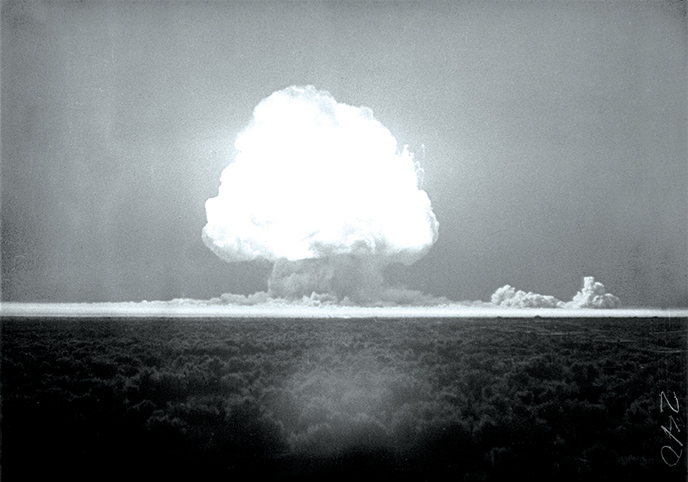
Fireball over the New Mexico desert, July, 1945 (courtesy Wikimedia Commons)
by Willie G. Moseley
Baby Boomers got their demographic designation from the proliferation of births over several years following the end of World War II. Most historians would likely agree the “boom” that occurred in the middle of the New Mexico desert 71 years ago, on July 16, 1945, at 5:29:45 a.m. Mountain War Time, not only shortened that war, but changed history forever. The then-top-secret location known as Trinity was the site of the world’s first atomic bomb test.
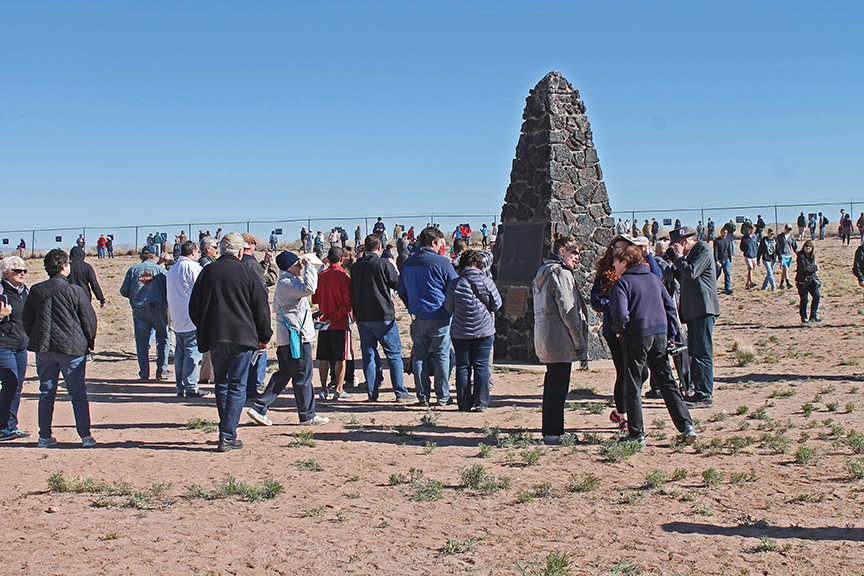
Visitors crowd around the obelisk, made from local lava rocks and erected at Ground Zero. (photo by Willie G. Moseley)
More than one atomic device had been developed at Los Alamos, an isolated, top-secret, government-supervised community approximately 200 miles north of Trinity.
Scientists from the U.S. and Great Britain labored in clandestine laboratories in a collective effort to create a destructive device that would unleash a new type of devastating power. The location chosen for the desert detonation of the first device was near a rugged, barren area known for centuries as the Jornada Del Muerto, or “route of the dead man.”
Shortly after the successful test at Trinity, two atomic bombs were dropped on Japan, quickly ending the war.
When America’s A-bomb program became public, many citizens were fascinated, and perhaps terrified, by the power of such devices. Yet for all of its ominous history and isolation, the Trinity site has, in recent times, evolved into a unique destination for history buffs, accessible only two days a year.
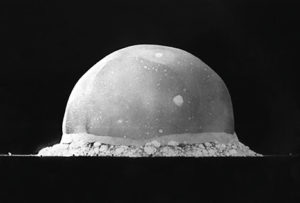
The Trinity A-bomb blast rises more than 600 feet less than two-tenths of a second after detonation. (photo courtesy Wikimedia Commons)
During WWII, what would become Ground Zero for the test was part of the U.S. Army’s massive Alamagordo Bombing and Gunnery Range, renamed White Sands Missile Range (WSMR) after the war. The WSMR is now responsible for the Trinity open house events on the first Saturdays of April and October. Due to extreme temperatures in the harsh desert environment, public events are not held on the mid-July anniversary.
“Annual tours first began in 1960 and were held in October,” said Camilla Montoya, a spokesperson for the WSMR. “Attendance was usually in the hundreds. The only time a special event was held on the exact day in July was for the 50th anniversary.”
Due to its isolation, trips to the site on open house dates should be planned in advance. Since Trinity is located on a restricted military base, civilian automobiles are subject to inspection, and must remain on the designated route to the site. Photography is not allowed except at the Trinity site itself.
Military gates allowing access to the Ground Zero site are open to the public from 8 a.m. to 2 p.m., with the site itself closing promptly at 3:30.
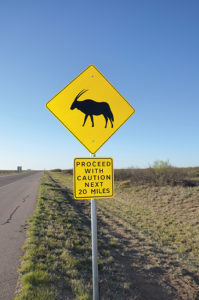
Oryx warning signs caution drivers on the White Sands Missile Range. (photo by Willie G. Moseley)
“Because of the remoteness of the site,” Montoya noted, “it was determined that this was ample time for visitors to view the site and not too long of a working day for the WSMR personnel who support the event. We close the site promptly at 3:30 to allow those visitors who come through the gate at 2 p.m. enough time to see everything.”
Motorists inside the WSMR will notice yellow warning signs on the restricted route which depict unusual silhouettes of horned animals. They’re not images of antelopes or deer, however, but the African Oryx, imported a half century ago.
“In the late ‘60s and early ‘70s,” said Montoya, “WSMR partnered with (the) New Mexico (Department of) Game and Fish to incorporate big game hunting on the range. As part of this effort about 100 African Oryx were brought here to see if they would adapt to the environment.”
According to Montoya, the Oryx not only adapted, but thrived, having no natural predator as they do in the Kalahari Desert. Three thousand now roam the range, their numbers kept in check by scheduled hunts.
Among the historical remnants of Trinity is the Schmidt-McDonald house, about two miles south of Ground Zero. It was in this building the A-bomb was assembled prior to its installation atop a 100-ft. tower at Ground Zero. During open houses, buses ferry visitors between the two sites, with portable restrooms, food items and souvenirs available during the events.
A 12-foot-tall obelisk holding two commemorative plaques stands at Ground Zero, made of lava rocks found in an ancient lava flow elsewhere on the WSMR. Signs at the site note the relatively minimal amount of residual radiation, comparing it to that found at other locations and occurrences.
The ferocious temperature of the 1945 nuclear detonation fused sand in the blast area into a greenish, glass-like substance known as Trinitite. Taking a piece of Trinitite as a souvenir is illegal.
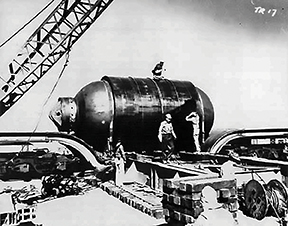
“Jumbo” was designed, but not used, to house the A-bomb during detonation. (courtesy Wikimedia Commons)
A giant cylinder also sits at the site. Christened “Jumbo” and weighing 214 tons, it was created to house the the atomic bomb, but ultimately wasn’t used. The monstrous container was blown apart in 1946 using conventional explosives.
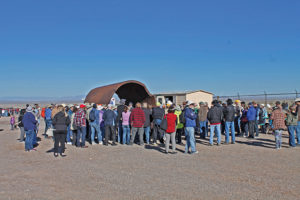
Visitors with the remains of “Jumbo.” (photo courtesy Willie G. Moseley)
According to Montoya, the open house on April 2 this year attracted almost 4,000 people, including two artists from Italy working on a mixed media project about Trinity.
As for the possibility of increasing the number of public events each year, Montoya is pragmatic.
“The remoteness of the site, test mission and limited personnel have been the main reasons this has never actually happened,” she said. “The missile range is 2.2 million acres. The main post is located 110 miles south—as the crow flies—of Trinity. It is almost a three-hour drive one way to the site.”
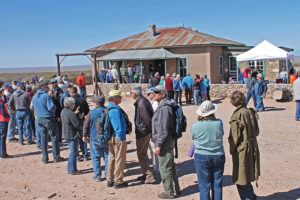
Visitors tour the Schmidt-McDonald house, part of the semi-annual public event. (photo by Willie G. Moseley)
According to Montoya, most White Sands organizations already struggle with limited support staff and budgets; working extra days outside of regular work schedules is costly and at times a safety concern.
“WSMR is an active test range for weapons systems,” she said. “Most days the area of Trinity Site is blocked due to the mission. We are guaranteed the two days per year without test interruption. This allows us to advertise and plan well in advance.”
The obelisk at Ground Zero stands as a silent stone sentinel, marking the spot where a major event in human history occurred. Visiting this historically important location, available to the public only two days each year, is a unique experience.
Author/columnist/lecturer Willie G. Moseley is the Senior Writer for Vintage Guitar Magazine, News Editor Emeritus for The Tallassee Tribune, and the author of twelve books. He may be reached at willie@vintageguitar.com.










One Response to “July 16, 1945: The Day Everything Changed”